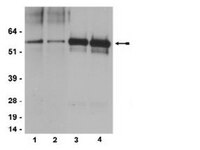Structure and regulation of Src family kinases.
Boggon, Titus J and Eck, Michael J
Oncogene, 23: 7918-27 (2004)
2004
Zobrazit abstrakt
Src family kinases are prototypical modular signaling proteins. Their conserved domain organization includes a myristoylated N-terminal segment followed by SH3, SH2, and tyrosine kinase domains, and a short C-terminal tail. Structural dissection of Src kinases has elucidated the canonical mechanisms of phosphotyrosine recognition by the SH2 domain and proline-motif recognition by the SH3 domain. Crystallographic analysis of nearly intact Src kinases in the autoinhibited state has shown that these protein interaction motifs turn inward and lock the kinase in an inactive conformation via intramolecular interactions. The autoinhibited Src kinase structures reveal a mode of domain assembly used by other tyrosine kinases outside the Src family, including Abl and likely Tec family kinases. Furthermore, they illustrate the underlying regulatory principles that have proven to be general among diverse modular signaling proteins. Although there is considerable structural information available for the autoinhibited conformation of Src kinases, how they may assemble into active signaling complexes with substrates and regulators remains largely unexplored. | 15489910
 |
The interplay between Src family kinases and receptor tyrosine kinases.
Bromann, Paul A, et al.
Oncogene, 23: 7957-68 (2004)
2004
Zobrazit abstrakt
Src family tyrosine kinases (SFKs) are involved in a diverse array of physiological processes, as highlighted in this review. An overview of how SFKs interact with, and participate in signaling from, receptor tyrosine kinases (RTKs) is discussed. And also, how SFKs are activated by RTKs, and how SFKs, in turn, can activate RTKs, as well as how SFKs can promote signaling from growth factor receptors in a number of ways including participation in signaling pathways required for DNA synthesis, control of receptor turnover, actin cytoskeleton rearrangements and motility, and survival are discussed. | 15489913
 |
Molecular interdiction of Src-family kinase signaling in hematopoietic cells.
Geahlen, Robert L, et al.
Oncogene, 23: 8024-32 (2004)
2004
Zobrazit abstrakt
The ability of Src-family kinases (SFKs) to mediate signaling from cell surface receptors in hematopoietic cells is a function of their catalytic activity, location and binding partners. Kinase activity is regulated in the cell by kinases and phosphatases that alter the state of phosphorylation of key tyrosine residues and by protein binding partners that stabilize the kinase in active or inactive conformations or localize the enzyme to specific subcellular or submembrane domains. Kinase activity and function can be modulated experimentally through the use of small molecule inhibitors designed to directly target catalytic or binding domains or regulate the location of the protein by altering its state of acylation. | 15489920
 |
Src protein-tyrosine kinase structure and regulation.
Roskoski, Robert
Biochem. Biophys. Res. Commun., 324: 1155-64 (2004)
2004
Zobrazit abstrakt
Src and Src-family protein kinases are proto-oncogenes that play key roles in cell morphology, motility, proliferation, and survival. v-Src (a viral protein) is encoded by the chicken oncogene of Rous sarcoma virus, and Src (the cellular homologue) is encoded by a physiological gene, the first of the proto-oncogenes. From the N- to C-terminus, Src contains an N-terminal 14-carbon myristoyl group, a unique segment, an SH3 domain, an SH2 domain, a protein-tyrosine kinase domain, and a C-terminal regulatory tail. The chief phosphorylation sites of Src include tyrosine 416 that results in activation from autophosphorylation and tyrosine 527 that results in inhibition from phosphorylation by C-terminal Src kinase. In the restrained state, the SH2 domain forms a salt bridge with phosphotyrosine 527, and the SH3 domain binds to the kinase domain via a polyproline type II left-handed helix. The SH2 and SH3 domains occur on the backside of the kinase domain away from the active site where they stabilize a dormant enzyme conformation. Protein-tyrosine phosphatases such as PTPalpha displace phosphotyrosine 527 from the Src SH2 domain and mediate its dephosphorylation leading to Src kinase activation. C-terminal Src kinase consists of an SH3, SH2, and kinase domain; it lacks an N-terminal myristoyl group and a C-terminal regulatory tail. Its X-ray structure has been determined, and the SH2 lobe occupies a position that is entirely different from that of Src. Unlike Src, the C-terminal Src kinase SH2 and SH3 domains stabilize an active enzyme conformation. Amino acid residues in the alphaD helix near the catalytic loop in the large lobe of C-terminal Src kinase serve as a docking site for the physiological substrate (Src) but not for an artificial substrate (polyGlu(4)Tyr). | 15504335
 |













